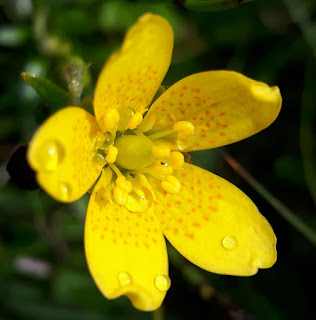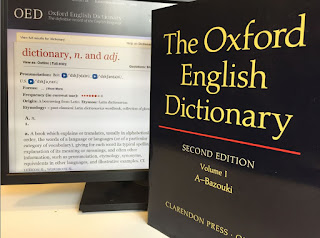| Chris leading an eyebright workshop at BSBI Recorders' Conference 2016 Image: S. Townsend |
They say that good things come to those who wait: after six years the publication of BSBI Handbook #18 Eyebrights of Britain and Ireland is only a few weeks away. I caught up with lead author Chris Metherell - no easy feat as Chris is also BSBI President and an incredibly busy man! I'm very grateful to Chris for agreeing to answer a few questions about the new Handbook so we can all get a glimpse into some of the work that went on behind the scenes to bring this latest BSBI publication to press.
LM: So Chris, the Eyebright Handbook is finally almost here – can
you remind us when you started working on it?
 |
| Euphrasia salisburgensis Image courtesy of John Crellin/ Floral Images http://www.floralimages.co.uk/page.php? taxon=euphrasia_salisburgensis,1 |
LM: You’ve visited a lot of locations during the research
phase – including many herbaria across Britain and Ireland. Are there any that stand out in your memory?
CM: "Fred and I
visited many corners of the UK and Ireland while working on this handbook, although I was the only one lucky enough to
get to Shetland! Four days spent on
Foula was pretty exceptional, dodging the bonxies being the main hazard, apart
from a force eight gale.
"Sunny days with
Fred and our guide Helena Crouch [County Recorder for Somerset] on the north coast of Cornwall were pretty
good too. In fact almost everywhere we
went the sun came out, even on Lewis
looking at Euphrasia campbelliae. Much of the
fieldwork was funded by grants from BSBI Science and Research Committee. We wouldn't have managed it otherwise".
| Chris and Helena looking at eyebrights in the West Country Image: F Rumsey |
LM: You’ve also led a lot of workshops at conferences and training events in herbaria – I guess the feedback you got from fellow botanists
proved really valuable here?
CM: "Yes, early on we decided to run workshops in order to
drum up support and also to test the keys and descriptions. We'd taken the unusual step of asking County Recorders what they wanted from the Handbook and the feedback was very useful. So we just expanded on that theme.
"The late Eric Meek was particularly
helpful but perhaps it's invidious to
pick out any one person. All the attendees
contributed to the process. I think I must
have rewritten the keys scores of times. It was the suggestion of having regional keys which really made a difference. But I can't now remember whose suggestion it
was!"
LM: Did you find visits to herbaria very helpful while
researching the Handbook?
 |
| Chris working in the herbarium at Univ. Reading Image: A. Culham |
CM: "Without herbaria
to consult, the process would have been impossible. Of course there's no substitute for field
work but we couldn't go everywhere and herbaria are so useful for capturing the
degree of variation in the species because one can look at hundreds of
specimens for a particular plant. And I
did!
"And having written the species
descriptions, these were tested in herbaria to check that they allowed for that
variation appropriately. My main base was E [the herbarium at the Royal Botanic Gardens, Edinburgh] whose staff were extremely helpful in obtaining specimens from other herbaria
for me to work on and I must single out RNG [the herbarium at University of Reading] for their encouragement. The fact
that I'm a Reading graduate has nothing to do with it! One of the highlights was finding a lost type specimen at SLBI [the herbarium at the South London Botanical Institute] on my first trip there".
LM: Illustrations
are an important part of any BSBI Handbook – who provided the line drawings and the
photographs?
 |
| Euphrasia tetraquetra Image courtesy of John Crellin/ Floral Images http://www.floralimages.co.uk/page.php? taxon=euphrasia_tetraquetra,1 |
CM: "Fred Rumsey did the
drawings and was the main photographer on our field trips but Helena Crouch,
John Crossley, Alex Twyford, Nick Sturt, Jenny Seawright, John O'Reilly and
Jeremy Roberts all provided images".
LM: I hear that there will be a launch event for the
Handbook – can you give us details please? Where is it being held and when, who
can attend and how do we book for the event?
CM: "We are having a launch at the Natural History Museum on Monday 18th June. I'll be able to give News & Views readers full details in the next day or two".
LM: Ooh thanks for the scoop Mr. President! In the meantime, I guess the priority is to let people know how they will be able to get hold of a copy:
 |
| Chris with a herbarium sheet of pressed, mounted specimens of - you guessed it - eyebrights! Image: L. Marsh |
- BSBI members can take advantage of the members-only special offer and pre-order their copy now at a discounted price (saving themselves £5.50). If you're a BSBI member, just head over to the members-only area of the BSI website and have your password ready. If you've forgotten your password, email enquiries@bsbi.org and we'll be able to help you.
- Non-members will be able to buy a copy later in June from Summerfield Books and other natural history book-sellers, although they won't benefit from the full discount.
So, huge thanks to Chris and Fred for putting this new BSBI Handbook
together. Watch this space for details of the launch, which will be covered on these pages for anyone who can't attend in person. We’ll also keep you all posted on initial sales, how the Handbook is received and whether it outsells the previous BSBI Handbook on Violas!
You can find a list of all the BSBI Handbooks on the BSBI Publications page, where there are links to information about each title on the Summerfield Books website.















